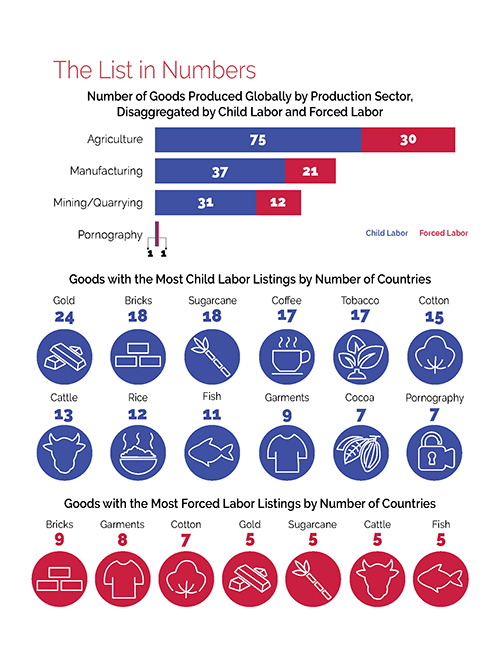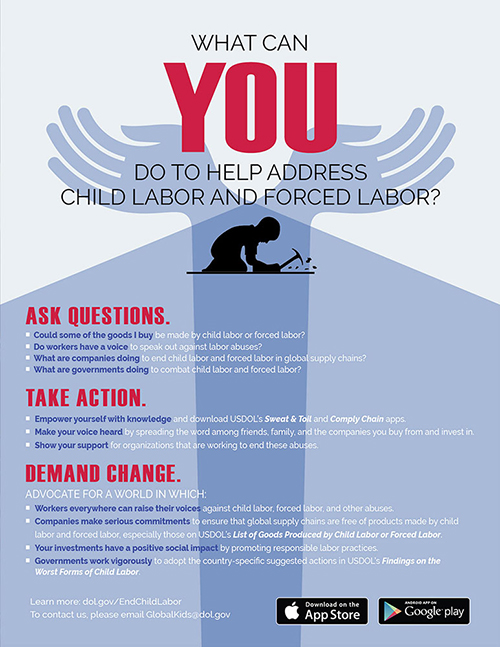List of Goods Produced by Child Labor or Forced Labor
The Bureau of International Labor Affairs (ILAB) maintains a list of goods and their source countries which it has reason to believe are produced by child labor or forced labor in violation of international standards, as required under the Trafficking Victims Protection Reauthorization Act (TVPRA) of 2005 and subsequent reauthorizations. The List of Goods Produced by Child Labor or Forced Labor comprises 159 goods from 78 countries and areas, as of September 28, 2022.
ILAB maintains the List primarily to raise public awareness about forced labor and child labor around the world and to promote efforts to combat them; it is not intended to be punitive, but rather to serve as a catalyst for more strategic and focused coordination and collaboration among those working to address these problems.
Publication of the List has resulted in new opportunities for ILAB to engage with foreign governments to combat forced labor and child labor. It is also a valuable resource for researchers, advocacy organizations and companies wishing to carry out risk assessments and engage in due diligence on labor rights in their supply chains.
The countries on the List span every region of the world. The most common agricultural goods listed are sugarcane, cotton, coffee, tobacco, cattle, rice, and fish. In the manufacturing sector, bricks, garments, textiles, footwear, carpets, and fireworks appear most frequently. In mined or quarried goods, gold, coal and diamonds are most common.
ILAB published the initial TVPRA List in 2009 and updated it annually through 2014, following a set of procedural guidelines that were the product of an intensive public consultation process. ILAB now updates and publishes the List every other year, pursuant to changes in the law.
Procedural Guidelines
On January 25, 2024, ILAB's Office of Child Labor, Forced Labor, and Human Trafficking published Procedural Guidelines for the development and maintenance of the List of Goods from countries produced by child labor or forced labor in violation of international standards.
| Country/Area Sort descending | Good | Exploitation Type |
|---|---|---|
| Bangladesh | Child Labor | |
| Bangladesh | Child Labor | |
| Bangladesh | Child Labor | |
| Bangladesh | Child Labor | |
| Bangladesh | Child Labor | |
| Bangladesh | Child Labor | |
| Bangladesh | There are reports that adults are working under forced labor conditions to produce garments in Bangladesh. Multiple surveys have reported that workers in the Ready-Made Garment (RMG) industry are subjected to excessive working hours beyond what is legally allowed, forced overtime, and withholding compensation. Furthermore, workers are subjected to physical and verbal abuse for not meeting targets. Women are often victims of physical and sexual abuse, including as punishment for not meeting targets. |
Child Labor, Forced Labor |
| Bangladesh | Child Labor | |
| Bangladesh | There are reports that children, mostly boys between the ages of 5-17, are forced to work in the production of dried fish in Bangladesh. According to the most recently available government data, close to 1,900 children, or about 24 percent of children working in the dried fish industry, are working under conditions of force. This forced child labor is found in the coastal districts of Borguna, Patuakhali, Chittagong, and Cox's Bazar of the Bay of Bengal, with the highest proportion of children in forced labor working in Bagherhat. According to the Government's data, some of the children work as bonded labor, often in exchange for advanced payments that have been made to their parents. These children are not free to leave the workplace, and some are not allowed any contact with their family. Some children are also forced to work under threat of physical violence and wage deductions. |
Child Labor, Forced Labor |
| Bangladesh | Child Labor |
your hand? Download ILAB's Sweat & Toil App today!
Are you a company looking to fight child labor and forced labor in supply
chains?





